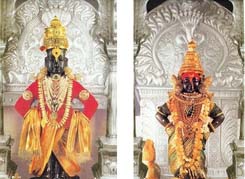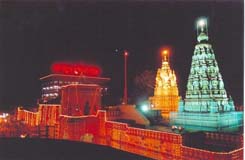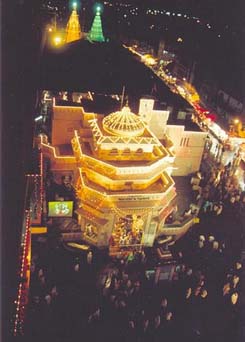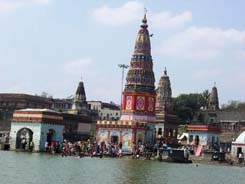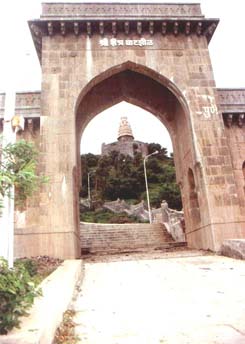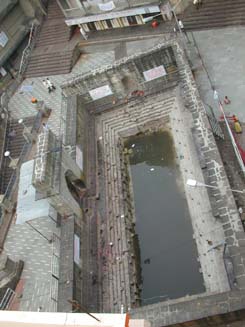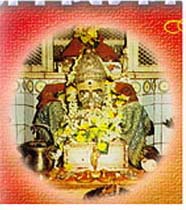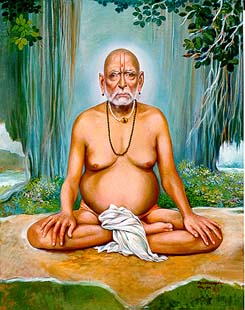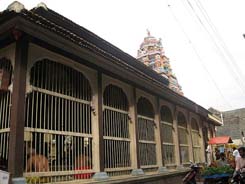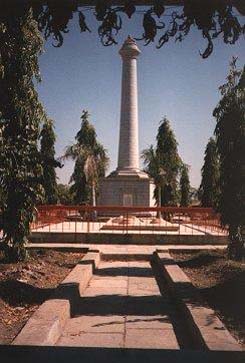Places Around Solapur
Pandharpur |
Pandharpur Pandharpur is a town in district Solapur in state of Maharashtra in Western India. It is one of the most revered pilgrimage sites in Maharashtra. It is located 65 km west of Sholapur, on the banks of the river Bhima, which is also known as Chandrabhaga. Known as "Sourthern Kashi of India", Pandharpur proudly hosts the "Kuladivat" of Maharashtra State- Shree Vithoba and Rukmini, on the banks of the river.Also known by the other names, Pandurang, Vitthal or Pandhari, it is supposed to be The Supreme God of The Universe for all the Maharashtrians and an incarnation of Lord Shiva and Vishnu. The word Vitthala is derived from the word Vishnu in Kannada. Panduranga is a sanskritized form of Pandarga, the old name of Pandharpur. Pundalik, a saint was closely associated with this shrine, and hence this shrine is also known as Pundarika pura. The worship of Vishnu - Vitthala at Pandharpur is derived mainly from the puranas and has been augmented by the contribution of the great Vaishnava saints of Maharashtra and Karnataka from the 13th through the 17th centuries like Dnyaneshwar, Namdev, Sant Eknath, Purandara Dasa, Vijaya Dasa, Gopala Dasa, Jagannatha Dasa, Chokhamela, Janabai and many others. Pandharpur is a town in district Solapur in state of Maharashtra in Western India. It is one of the most revered pilgrimage sites in Maharashtra. It is located 65 km west of Sholapur, on the banks of the river Bhima, which is also known as Chandrabhaga. Known as "Sourthern Kashi of India", Pandharpur proudly hosts the "Kuladivat" of Maharashtra State- Shree Vithoba and Rukmini, on the banks of the river.Also known by the other names, Pandurang, Vitthal or Pandhari, it is supposed to be The Supreme God of The Universe for all the Maharashtrians and an incarnation of Lord Shiva and Vishnu. The word Vitthala is derived from the word Vishnu in Kannada. Panduranga is a sanskritized form of Pandarga, the old name of Pandharpur. Pundalik, a saint was closely associated with this shrine, and hence this shrine is also known as Pundarika pura. The worship of Vishnu - Vitthala at Pandharpur is derived mainly from the puranas and has been augmented by the contribution of the great Vaishnava saints of Maharashtra and Karnataka from the 13th through the 17th centuries like Dnyaneshwar, Namdev, Sant Eknath, Purandara Dasa, Vijaya Dasa, Gopala Dasa, Jagannatha Dasa, Chokhamela, Janabai and many others. This temple, covering a vast area, has a total of six gates. The eastern entrance to this temple is known as the Namdev gate. The sanctum enshrines a standing image of Vithoba. Stylistically the image dates back to the 5th century BC. There are inscriptions in this temple dating back to the 13th century. In the temple of Vithoba, `Pad-Sparsha-Darshan`, is a special ceremony. Irrespective of caste any devotee can enter the sanctum sanctorum and can place his/ her head at the feet of Vitthal. Although not religiously very crucial, certain daily rituals do form the routine of Bhaghwat Dharma, at Pandharpur. These signify the devotedness of the followers towards its deity. These rituals include Kakad Arati (Early Morning Prayers), Mahapuja (Mega-Worship), Mahanaivedya (Food offering), Poshakh (putting the robe) Dhoop Arati, Padya Pooja, etc. All this is performed in main Vitthal temple. As one enters from Namdeo-Payri (The Step in memory of Saint Namdeo) and comes out of the Westward Exit (the Paschim Dwar) one crosses various other temples- as many as 25, in the same premises, like the Ganesh Mandir, Garud Mandir, Ekmukh Dattatraya Mandir, Satyabhama Mandir, Kanhopatra Mandir to name a few. By Air - Nearest airport is Pune, 204 kms. By Rail - Nearest railhead is Pandharpur on the Kurduwadi - Miraj line of South Central Railway. But a more convenient railhead is Solapur, 74 kms. By Road - Mumbai - Pandharpur, 386 kms. Pune Pandharpur, 204 kms
|
|
Tuljapur Tuljapur is very famous pilgrimage centre for its Tuljabhavani temple. It is situated in Osmanabad district in the state of Maharashtra.The town is home to a famous temple dedicated to the Hindu Goddess Bhavani. The town received much importance in past centuries, since the temple enjoys a special association with the Bhonsale clan to which Chhatrapati Shivaji belonged. Goddess Bhavani was the family deity of the Bhonsale clan. The temple-town of Pandharapura, the Dharashiv caves, and the fort of Naldurg all lie within easy reach. As the Goddess Bhavani is the deity of many people from Maharashtra, Karnataka and Andhra Pradesh they come walking in Dasera Festival to worship Goddess Bhavani. S.T.B College of Engineering (http://www.stbcet.org.in/) is also located in the same town. The Tata Institute of Social Sciences, Mumbai, a deemed university of international repute has started a B.A. in Social Work (with specialsation in Rural development) programmne near Tuljapur. This is a temple town which rose to prominence during the Maratha regime and the goddess was a family deity of the Bhosle rulers. Chhatrapati Shivaji used to take her blessings for success in his military campaigns. It is believed that the Tulja Bhavani presented Shivaji with the Bhavani sword. Tuljapur is one of the holy place in Maharashtra in Osmanabad district. This place comes under the Marathwada region located 270 meter above sea level on the hills called as Balaghat. The name of this town was "Chinchpur" as this place is full of Tamarind trees, but, later on changed to "Tuljapur" after the name of Shree Tulja Bhavani. Now it is considered one of the main holy places in India. Lakhs of devotees from all over the country visit this place. The place has religious significance during the period of "Navratra". Pandharpur and Akkalkot are the other nearby places of religious significance. Kallol tirth The second among the 'Shaktipeeths' is Tulja Bhavani of Tuljapur. It was the family deity of the Bhosale kings. Shivaji always visited the temple to seek her blessings. It is believed that the Goddess gifted him a sword - 'the Bhawani sword' - for success in his expeditions. The history of the temple has been mentioned in the "skanda puran". There was a sage known as "Kardam" After his death his wife "Anubuti" had performed a penance at the banks of river "mandakini " for Bhavani mata to look after her infant child. While performing the penance the demon known "Kukur" tried to disturb her penance during which Mata Bhavani came to the aid of "Anubuti" and killed the demon "Kukur". From that day onwards the Goddess Bhavani came to be known as Tulja Bhavani. The temple is located on the hill of "Bala ghat". The same place is today known as Tuljapur. The Idol: The Idol of the Shree Tulja Bhavani mata is a "swayambu" idol. The goddess is having eight hands sitting on a thrown. |
|
Akkalkot Shri Swami Samarth Maharaj Akkalkot is a Holy place of Shri.Swami Samarth Maharaj. It is located at a distance of 38 kms. by road from Solapur District headquarters. This Saint is believed to be the reincarnation of Lord Dattatraya. The Samadhi of this Saint is worshipped by the devotees. The Death Anniversary is celebrated on Chaitra Shuddha Trayodashi every year. Large number of devotees visit the place. The present temple is built around famous banyan tree. This is the same banyan tree sitting under which Shri.Swami Maharaj used to meditate and preach the followers. The temple consists of main temple, sabha mandap and accommodation. Annacchatra (free meals to devotees) is organized daily (two times in day) by temple authorities. The Swami Samarth Maharaj came to Akkalkot at the beginning of Shake 1779. The total period of reincarnation of Swamiji as the fourth Avataar of Shri. Datta is forty years of which he spent 21 years in Akkalkot. In and around Akkalkot, there are other minor places of interest like the ashrams and samadhis of various disciples of Swami Samarth. These places are not as popular as the main temple, but are worth a visit simply because the places have been maintained quite well, and are exactly as they used to be, and one can still feel the atmosphere that comes from years of meditation and penance. The best way to visit all these places is to hire a local auto driver as a guide. The chaps are only too happy to take one around the village for 50 Rupees. Around 2 Km from Akkalkot is another place worth a visit for a traveler on a spiritual quest. The Shivpuri Ashram is a legacy of one of Swami Samarth's disciples, Shree Gajanan Maharaj (not the Gajanan maharaj of Shegaon), and his father, Shree Yogindra Maharaj. They were responsible for the revival of the ancient system of Agnihotra, or the maintenance of the sacred fire. The ashram is a serene place, with the Samadhi of the swamiji and his descendants and disciples. It is amazing how they have managed to popularize the age old concept of Agnihotra. The holy Samadhi of Shri. Swamiji is loacated in the house of shri. Cholappa in the place already reserved for it before his bodily demise. This is known as Samadhimath. The spiritual fearless slogan in marathi ‘BHIU NAKOS MI TUJHYA PATHISHI AAHE’ (Don’t fear, I am with you) is given by Shri. Samarth Swami Maharaj himself. The name of Akkalkot Maharaj Swami Samarth comes in Shirdi Saibaba's Sai Satcharitha. Hence, All the sai devotees must and should visit this holy place of Akkalkot without fail atleast once during their lifetime and get the blessings of the great Datta Avatar Shri. Swami Samarth. |
